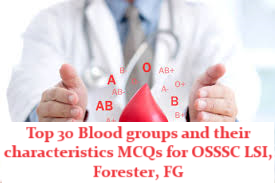Blood groups are determined by the presence or absence of specific antigens and antibodies in the blood. Understanding blood groups and their characteristics is crucial in various fields, including forensic science, medical diagnostics, and transfusion medicine. For candidates preparing for exams like the OSSSC (Odisha Sub-ordinate Staff Selection Commission) LSI (Livestock Inspector) and Forester FG (Forest Guard), having a solid grasp of blood group concepts is essential. Here, we present a set of multiple-choice questions (MCQs) covering the top 30 blood groups and their characteristics to aid in exam preparation.
- What are the components of blood?
a) Red blood cells and platelets
b) White blood cells and plasma
c) Red blood cells, white blood cells, and platelets
d) Plasma and antigens
Answer: c) Red blood cells, white blood cells, and platelets - Which of the following is NOT a function of antibodies?
a) Recognizing foreign substances
b) Alerting the immune system
c) Destroying red blood cells
d) Part of body’s natural defenses
Answer: c) Destroying red blood cells - Where are antigens found in the blood?
a) In plasma
b) On the surface of red blood cells
c) Inside white blood cells
d) Attached to platelets
Answer: b) On the surface of red blood cells - What is the primary role of antibodies in the body?
a) Fighting infections
b) Promoting blood clotting
c) Transporting oxygen
d) Recognizing foreign substances
Answer: d) Recognizing foreign substances - How is blood group identified?
a) By the color of blood cells
b) By the size of platelets
c) By the presence of antigens and antibodies
d) By the number of white blood cells
Answer: c) By the presence of antigens and antibodies - Which blood group has A antigens on the red blood cells?
a) Blood group A
b) Blood group B
c) Blood group O
d) Blood group AB
Answer: a) Blood group A - Which blood group has B antigens on the red blood cells?
a) Blood group A
b) Blood group B
c) Blood group O
d) Blood group AB
Answer: b) Blood group B - Which blood group has both A and B antigens on the red blood cells?
a) Blood group A
b) Blood group B
c) Blood group O
d) Blood group AB
Answer: d) Blood group AB - Which blood group has no antigens on the red blood cells?
a) Blood group A
b) Blood group B
c) Blood group O
d) Blood group AB
Answer: c) Blood group O - Which blood group has both anti-A and anti-B antibodies in the plasma?
a) Blood group A
b) Blood group B
c) Blood group O
d) Blood group AB
Answer: c) Blood group O - Which blood group’s plasma contains anti-B antibodies?
a) Blood group A
b) Blood group B
c) Blood group O
d) Blood group AB
Answer: a) Blood group A - Which blood group’s plasma contains anti-A antibodies?
a) Blood group A
b) Blood group B
c) Blood group O
d) Blood group AB
Answer: b) Blood group B - Which blood group can be safely given to any other group?
a) Blood group A
b) Blood group B
c) Blood group O
d) Blood group AB
Answer: c) Blood group O - What percentage of the UK population has blood group O?
a) Around 25%
b) Around 33%
c) Around 48%
d) Around 50%
Answer: c) Around 48% - Why must group A blood never be given to someone with group B blood and vice versa?
a) Because it can cause an allergic reaction
b) Because it can cause blood clotting
c) Because their antibodies will attack the foreign blood cells
d) Because it can lead to organ rejection
Answer: c) Because their antibodies will attack the foreign blood cells - What happens if your blood contains B antigens and is mixed with anti-B antibodies?
a) It clumps together
b) It remains unchanged
c) It turns blue
d) It becomes viscous
Answer: a) It clumps together - How is blood group O identified in a series of tests with different antibody solutions?
a) It reacts with anti-A antibodies
b) It reacts with anti-B antibodies
c) It doesn’t react to any anti-A or anti-B antibodies
d) It reacts to both anti-A and anti-B antibodies
Answer: c) It doesn’t react to any anti-A or anti-B antibodies - What is the purpose of mixing donor blood with recipient blood during a transfusion?
a) To create a reaction
b) To identify blood groups
c) To cause clotting
d) To check compatibility
Answer: d) To check compatibility - Which antigens are tested for during a blood transfusion?
a) ABO and RhD antigens
b) A and B antigens
c) RhD antigens only
d) AB antigens
Answer: a) ABO and RhD antigens - If there’s no reaction during a blood transfusion test, what does it indicate?
a) The donor blood can be used
b) The recipient blood needs further testing
c) The donor blood cannot be used
d) The recipient blood is incompatible
Answer: a) The donor blood can be used - Which blood group contains both A and B antigens?
a) A
b) B
c) AB
d) O
Answer: c) AB - Which blood group can receive blood from any other blood group during a transfusion?
a) A
b) B
c) AB
d) O
Answer: d) O - If someone has A antigens on their red blood cells, which antibodies would react with their blood?
a) Anti-A antibodies
b) Anti-B antibodies
c) Both anti-A and anti-B antibodies
d) Neither anti-A nor anti-B antibodies
Answer: a) Anti-A antibodies - What does it mean if blood clumps when mixed with anti-A antibodies?
a) The blood group is A
b) The blood group is B
c) The blood group is AB
d) The blood group is O
Answer: a) The blood group is A - What type of blood can a person with blood group AB receive during a transfusion?
a) Only AB blood
b) Only A blood
c) Only B blood
d) Any blood type
Answer: d) Any blood type - Why are pregnant women always given a blood group test?
a) To check for iron deficiency
b) To determine their Rh factor
c) To diagnose diabetes
d) To assess cholesterol levels
Answer: b) To determine their Rh factor - What could happen if an RhD-negative mother carries a fetus with RhD-positive blood without treatment?
a) Gestational diabetes
b) Rh incompatibility complications
c) Pre-eclampsia
d) Postpartum hemorrhage
Answer: b) Rh incompatibility complications - What is the significance of Rh factor in pregnancy?
a) It determines the baby’s gender
b) It affects the mother’s blood pressure
c) It can cause autoimmune diseases
d) It may lead to maternal-fetal blood incompatibility
Answer: d) It may lead to maternal-fetal blood incompatibility - What blood type should RhD-negative women of child-bearing age receive?
a) RhD-positive
b) RhD-negative
c) AB positive
d) O negative
Answer: b) RhD-negative - Which of the following is a preventive measure for Rh incompatibility during pregnancy?
a) Blood transfusion
b) Rh immunoglobulin injection
c) Antibiotic therapy
d) Herbal supplements
Answer: b) Rh immunoglobulin injection










